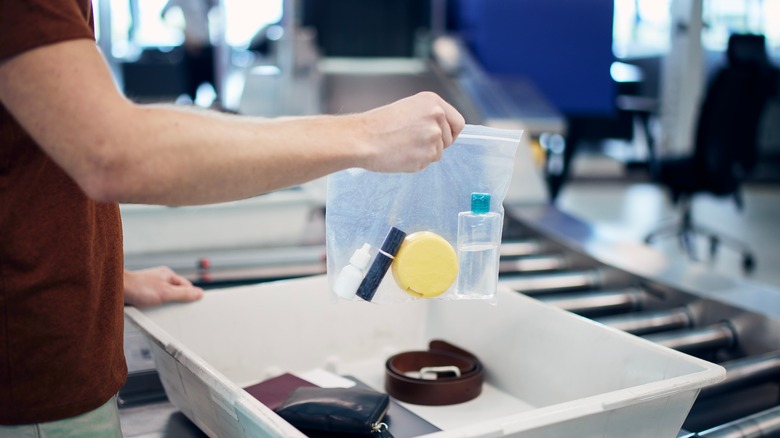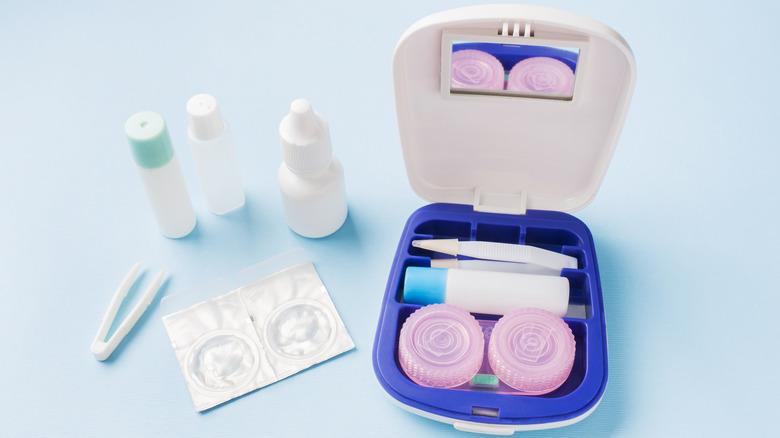Does TSA Consider Contacts To Be Liquid? Here's How To Travel With Your Lenses
Flying with contact lenses is a must for poorly sighted folks — the freedom from wearing glasses allows you to be more active and adventurous, giving you the leeway to even pack and wear sunglasses for your journey. However, transporting them can sometimes be a source of confusion, especially when navigating airport security. The Transportation Security Administration (TSA) has specific guidelines about what can and cannot be carried in your carry-on and checked luggage, and knowing these rules will help you ensure a smooth journey. One common question among travelers who wear this vision aid is whether TSA considers contact lenses or contact lens solutions to be liquid (or medicine) and how best to travel with these items.
The simple answer is no; contact lenses themselves are not considered liquids by the TSA. They are allowed inside your carry-on and checked bag without any restrictions, but it is safer to pack your contact lenses inside your carry-on. This will protect them from damage due to pressure and temperature changes in the checked baggage compartment. However, the same cannot be said for the solutions used to clean and store contact lenses or contact lens rewetting drops. Contact lens solutions are indeed considered liquids and must adhere to the TSA's 3-1-1 rule. This rule dictates that any liquids, gels, or aerosols inside your carry-on luggage must be in containers no larger than 3.4 ounces, placed in a single, quart-sized, clear plastic, zip-top bag (one per passenger).
Contact lens solution and the 3-1-1 rule
Even though it's one of the important travel items exempt from TSA's liquid rules, if you plan on carrying more than 3.4 ounces of contact lens solution in your carry-on, you must declare it to security officers at inspection. Although the solution is considered a medically necessary liquid, it may still trigger an alarm or test positive for prohibited chemicals during screening and might not be allowed through. To avoid this problem, the best thing to do is to purchase a travel-sized bottle of the solution. Most brands are available in bottles that comply with the 3.4-ounce limit, easily found in drugstores, supermarkets, or online.
If your loyalties lie with a particular brand but it isn't available in a travel-sized bottle, you can purchase a refillable bottle that meets TSA's size requirements and transfer the solution before your trip. When it comes time to pack, place the quart-sized bag containing your contact lens solution in an easily accessible part of your carry-on luggage — it will help facilitate a quicker and smoother screening process at the security checkpoint.
For international trips, it's important to check the specific regulations of your destination country. Even though TSA guidelines are widely recognized, other countries may have different rules regarding the transportation of liquids. Some airports, like those in UAE, Mexico, and South Korea, have very strict security protocols at the border, while others are more laid-back.
Tips for traveling with contact lenses
Eye care goes hand in hand with appreciating the sights on your travels. To ensure that your eyes, contacts, and contact solution are well taken care of, consider the following tips. First, pack more contacts than you think you need. If you wear monthlies, an extra pair or two, and if you use daily disposable lenses, bring enough backup to last a week. You never know what might happen on your journey; you might lose or damage your contacts or get an eye infection requiring you to switch pairs after you're healed. Carry a pair of glasses with you and repurpose the glasses case as a packing tool! A copy of your contact and eyeglasses prescription in case you need to purchase more while abroad is a must.
On the airplane, stay hydrated. The cabin has notoriously low humidity that can dry your lenses and eyes in no time. Drink plenty of water and use rewetting drops to keep your eyes moist. If you know that you have sensitive eyes, wear your glasses on the flight and switch to contacts once you land. If you plan on wearing lenses on a long-haul flight, take them out to sleep. When handling your contacts — on the airplane or anywhere else on your travels — always wash your hands and follow hygiene practices. Lastly, a clean contact lens case filled with fresh solution is essential for storing your lenses if you need to remove them during your flight.


